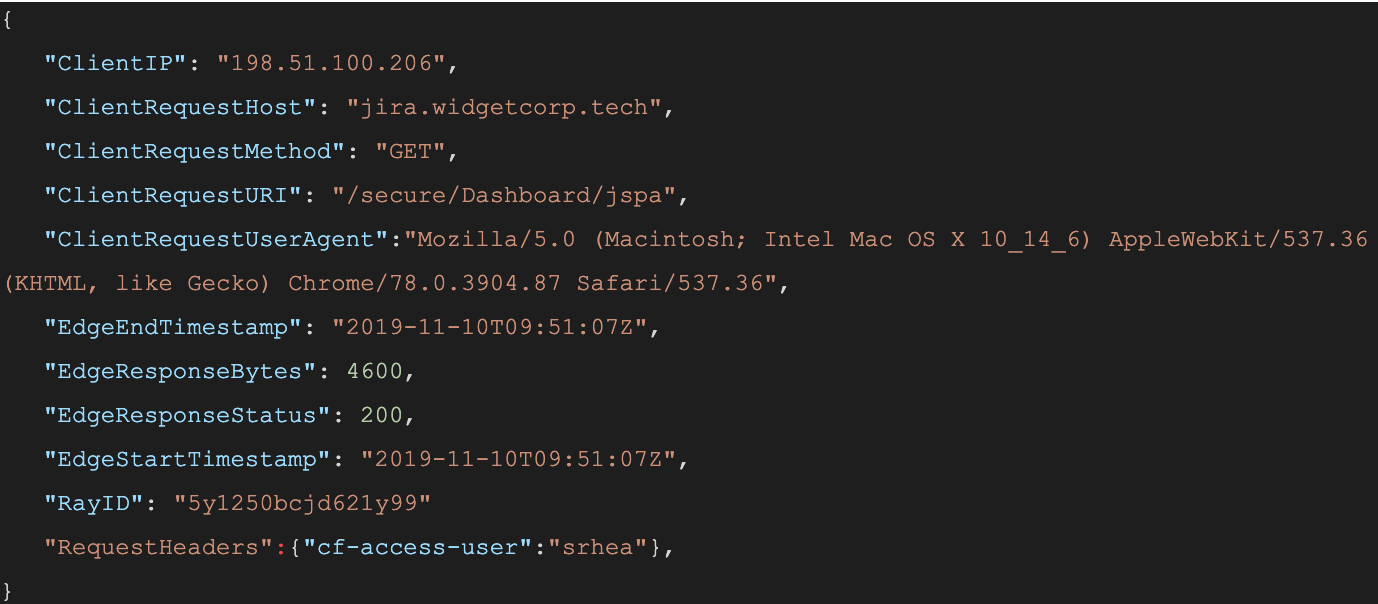Log every request to corporate apps, no code changes required

When a user connects to a corporate network through an enterprise VPN client, this is what the VPN appliance logs:
The administrator of that private network knows the user opened the door at 12:15:05, but, in most cases, has no visibility into what they did next. Once inside that private network, users can reach internal tools, sensitive data, and production environments. Preventing this requires complicated network segmentation, and often server-side application changes. Logging the steps that an individual takes inside that network is even more difficult.
Cloudflare Access does not improve VPN logging; it replaces this model. Cloudflare Access secures internal sites by evaluating every request, not just the initial login, for identity and permission. Instead of a private network, administrators deploy corporate applications behind Cloudflare using our authoritative DNS. Administrators can then integrate their team’s SSO and build user and group-specific rules to control who can reach applications behind the Access Gateway.
When a request is made to a site behind Access, Cloudflare prompts the visitor to login with an identity provider. Access then checks that user’s identity against the configured rules and, if permitted, allows the request to proceed. Access performs these checks on each request a user Continue reading
Dell Technologies CTO: Why AI Needs Empathy
If we want humans to trust artificial intelligence, then we need to teach the machines empathy,...
Writing userspace USB drivers for abandoned devices
Writing userspace USB drivers for abandoned devices
Palo Alto Networks Leaps Into SASE Market
Fulfilling Gartner's predictions, Palo Alto Networks announced its transition to a secure access...
Carrier supporting Carrier with BGP-LU
In our last post we talked about the less used method of deploying CsC where we ran OSPF and LDP inside the CSC-PE routing-instance.
Note: I can’t help myself apparently so be aware that Carrier of Carriers (CoC) is the same as Carrier supporting Carrier (CsC)
This required some changes to be made to our default LDP export policy as well as how we moved routes between the inet.3 and inet.0 tables. That being said, if you’re a single org it might make good sense to run things that way. I liked how you were able to see all of the remote LDP domain loopbacks in your local inet.3 table which in my mind made it easier to imagine the LSP paths.
That being said, it is clearly not the preferred deployment methodology. Most examples you’ll find leverage BGP (BGP-LU specifically) for the CSC-CE to CSC-PE connections as well as within the local label domains. So in this example, we’ll do just that. Larges chunks of the base configuration will be the same as they were in the previous post but for the sake of clarity I’ll post our starting post the starting configurations and diagrams here Continue reading
IETF 106 Begins Nov 16 in Singapore – Here is how you can participate remotely in building open Internet standards

Starting Saturday, November 16, 2019, the 106th meeting of the Internet Engineering Task Force (IETF) will begin in Singapore. Over 1,000 engineers from around the world will gather in the convention center to join together in the debates and discussions that will advance the open standards that make the Internet possible. They are gathered, in the words of the IETF mission, “to make the Internet work better“.
Pick your protocol – the future of DNS, DOH, TLS, HTTP(S), QUIC, SIP, TCP, IPv6, ACME, NTP… and many, many more will be debated in the rooms and hallways over the next week.
What if you cannot be IN Singapore?
If you are not able to physically be in Singapore this week, the good news is you can participate remotely! The IETF website explains the precise steps you need to do. To summarize quickly:
- Register as a remote participant. There is no cost.
- Review the agenda to figure out which sessions you want to join. (I will note that there are some very interesting (to me!) Birds-of-a-Feather (BOF) sessions at IETF 106.)
- Choose the channel(s) you will use to participate, including:
- Meetecho (video, slides, audio, and chat)
- Audio Continue reading
Weekly Wrap: Juniper Guns for Cisco, Aruba With Mist AI
SDxCentral Weekly Wrap for Nov. 15, 2019: Juniper enhances its Mist AI platform and launches a new...
Microsoft Earns Top Marks in Industrial IoT
It was lauded for adding features to its IoT platform at an “impressive rate” with richer edge...
Amazon Challenges Pentagon’s $10B JEDI Award
“It’s critical for our country that the government and its elected leaders administer...
How to Network for a Job
When most people hear the phrase “job networking,” they think of those white collar career type jobs that may eventually lead to someone becoming a CEO or owner of a big company. However, whether you are looking for a job in a top 500 company, or simply looking for a job with a construction company, as a cook, or as a teacher here are some helpful tips on how to network for a job.
How to Network for a Job in 6 Easy Steps
Build a Network Before Your Actually Need One
The minute you decide on the type of job that you really like, you should start building a network of people who can offer advice, let you know about job openings, and will spread the word when you are ready to start the job of your choice. Build your network of people in the trade or business you are interested in, related businesses, and people who have influence in the community, as well as people with whom you may share other interests.
Maintain Your Network
Once you have a network in place, begin maintaining your network. Call or email the people regularly just to ask how they are Continue reading
AI and Trivia

Photo by Pixabay on Pexels.com
I didn’t get a chance to attend Networking Field Day Exclusive at Juniper NXTWORK 2019 this year but I did get to catch some of the great live videos that were recorded and posted here. Mist, now a Juniper Company, did a great job of talking about how they’re going to be extending their AI-driven networking into the realm of wired networking. They’ve been using their AI virtual assistant, named “Marvis”, for quite a while now to solve basic wireless issues for admins and engineers. With the technology moving toward the copper side of the house, I wanted to talk a bit about why this is important for the sanity of people everywhere.
Finding the Answer
Network and wireless engineers are walking storehouses of useless trivia knowledge. I know this because I am one. I remember the hello and dead timers for OSPF on NBMA networks. I remember how long it takes BGP to converge or what the default spanning tree bridge priority is for a switch. Where some of my friends can remember the batting average for all first basemen in the league in 1971, I can instead tell you all about Continue reading